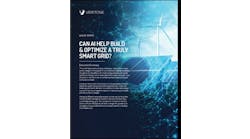Ryan Franks, of the National Electrical Manufacturers Association, explains why microgrids are a public good and how NEMA is working to overcome challenges to their development.
There is a philosophical way to think about the contribution microgrids can make to the world: that electricity can be thought of as a public good much like public security or public health.
As does much of the developed world, the U.S. depends on electricity. It fuels our personal and communal prosperity, allows us to be safe and comfortable, and permits us to work more efficiently. This makes the electrical grid critical infrastructure. Further, other critical infrastructure, including water and communications systems, requires electricity to function. It is potentially dangerous (and frankly unconscionable) that in the 21st century the number of electricity outages continues to increase and that millions around the world do not have regular access to reliable electric power.
Outages are the result of aging infrastructure that is more prone to failure as it nears the end of its life, exacerbated by severe weather events and other natural disasters. Utilities and the electrical grid also face deliberate physical and cyber security threats that society must take prudent steps to prevent.
In June 2014, the U.S. Environmental Protection Agency released a Clean Power Plan Proposed Rule that mandates carbon emissions from the power sector be reduced 30 percent below 2005 levels nationwide. While the methods of achieving this reduction are not settled, it is likely many older power generators will be forced to retire. Plausibly, this generation will be offset somewhat by distributed renewable generation sources and demand reduction efforts.
Microgrids work as a controllable system of interconnected loads (i.e., users), on-site generation resources, and energy storage which can operate in grid-connected or island (grid-disconnected) modes. The ability to control these systems and connect/disconnect from the macrogrid explains how they are feasible solutions to many challenges. Microgrids mitigate the effects of cyber attacks, physical attacks, weather, or component failure by insulating or isolating the service area from the source of trouble.
On-site generation with storage ensures a reliable supply of electricity even in the face of outages — regardless of their cause and duration. The controllability also aids in increasing the integration of renewables as our nation’s, and others’ generation mix changes from large, central plants to smaller, distributed sources. Electric transmission and distribution grids are designed to handle maximum capacity and peak loads, which are only going to grow. Microgrids allow utilities (and other systems operators) to focus capital investment on maintaining peak load design and reliability.
Challenges to increasing the adoption of microgrids exist, however. Unfavorable or vague regulations from jurisdictional commissions, insufficient interoperability of constituent components, and a lack of common approaches to the design, financing, construction, and operation; and lack of an understanding of the aforementioned benefits are often present. NEMA and its members recognize the benefits and the challenges, and as a result, microgrids are a NEMA Strategic Initiative beginning in 2015.
NEMA is developing a voluntary consensus standard outlining performance and design considerations for classifications of microgrids. This document is similar to Telecommunication Industries Association standard 942 (TIA-942), which established the tiers of data centers that are commonly referenced. The standard facilitates a conversation and common understanding among decision makers, finance providers, and engineers regarding what the microgrid project in question is, what needs it satisfies, and what problems it solves.
In addition to promoting this framework internationally, NEMA is representing the U.S. in preexisting International Electrotechnical Commission bodies to collaborate with other nations and ensure that international standards take North American system considerations into account.
Primarily at the state level, the strategic initiative addresses regulatory reform, promotion of carve-outs for energy storage, and other policies enabling microgrid development concurrent to technical efforts. Advocacy and education is done with public utilities commissions and broader efforts including the New York Reforming the Energy Vision initiative.
Microgrids are beneficial for the customer, the utility, and the environment. They enable electricity to be provided reliably and affordably to more people, and may offer a suitable solution to bring electricity to areas of the world that currently do not have it. NEMA and its membership are working to overcome the challenges to their implementation. The resulting quality of life improvements are the very definition of what makes electricity a public good.
Ryan Franks is technical program manager for the National Electrical Manufacturers Association (NEMA).






